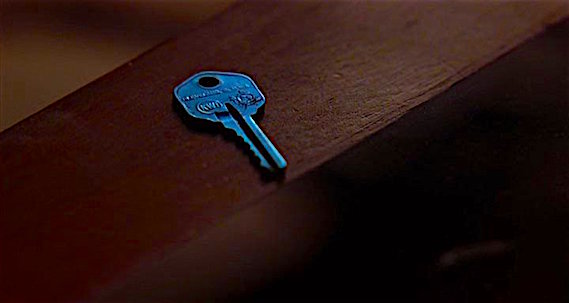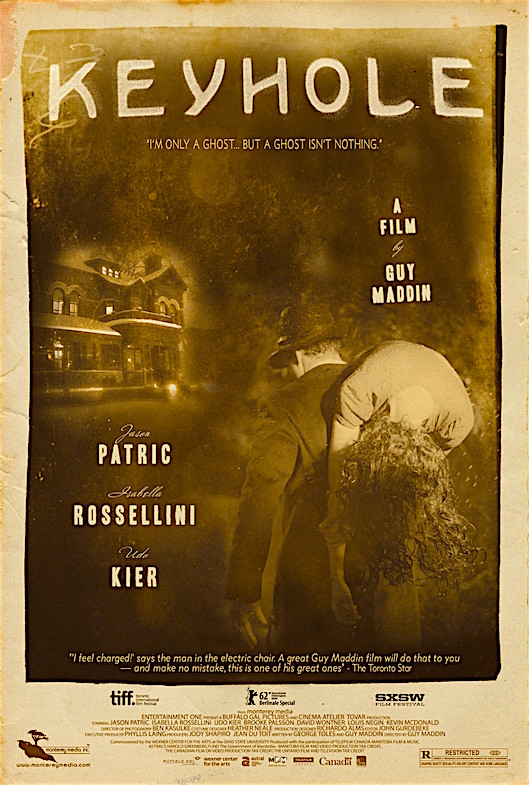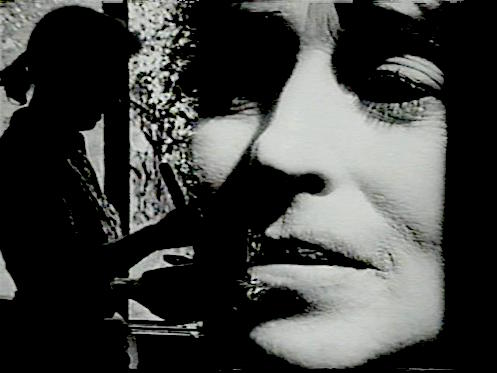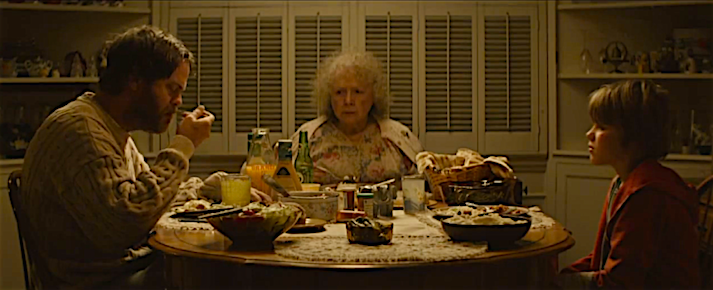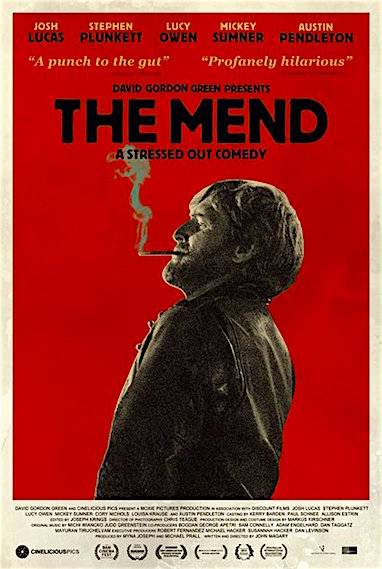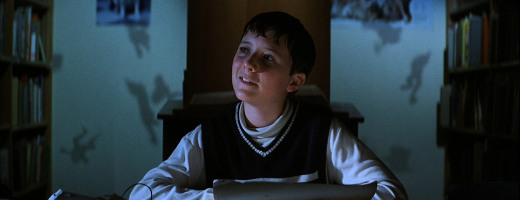People always ask me why I like such dark and often surreal movies. For me, these strange cinematic explorations into the darkest corners of the human mind act as a sort cathartic entertainment. But perhaps on a deeper level they hold an interest for me that allows me to feel a bit lucky compared to the characters and images struggling through crisis of reality, circumstance and identity.

Roaming through an old house, a gangster faces dangers of memories and lingering ghosts…
Keyhole
Guy Maddin, 2011
Cinematography | Benjamin Kasulke
Struggle. This is what I have been doing on a daily basis for the last several years. It is not so much that I need to learn the techniques to calming my subconscious, I know them. The challenge is putting them into action so that these exorcises actually become tools I can use. It seems like a simple thing to master, but the subconscious is an alternate world filled with illogical concerns and masterful ways to impede the conscious state from doing what it needs to do. Finding the pathway into the subconscious takes a great deal of work all with an eye toward not making it think that the conscious is out to defeat it. While the process seems to lend itself to the idea of Zen Yoga Meditation, it is a great deal more complex.

Studying more than mental illness or simple concepts of identity, Paddy Chayefsky’s script was unfilmable, but Ken Russell speeded-up the dialogue. The sense of self, reality and identity are deconstructed to a whole new level.
Altered States
Ken Russell, 1980
Cinematography | Jordan Cronenweth
After three decades of a successful life, my subconscious coping skills began to fall apart. By the time I slammed into 42 years of age I was no longer successful. I was stumbling, falling and lost. Fast forward a couple of years and far too many doctors and tests later I found out with what I was dealing. I had known for some time that I was living with PTSD, but when two doctors and a therapist informed me I was actually living with a more extreme form of PTSD known as DID (Dissociative Identity Disorder.)
I was God-smacked. It would take me a full year before I could actually believe this diagnosis to be true. And it has taken a couple more to fully acknowledge and own it. In the last year I’ve become far better at turning technique into tool, but I am far from attaining Master – Level Use.

Sneaking a peak beyond the other side of a keyhole, “Ulysses Pick” sees far more than he can process.
Keyhole
Guy Maddin, 2011
Cinematography | Benjamin Kasulke
A life-long friend who I consider to be my sister is in The City for work. This is one of the dearest people in my world. There is no way I’m going to miss visiting and hanging with her. But challenges spring forward intent on preventing me from being out in public spaces. After the recent tragic terrorist attacks, my phobia of being in crowded spaces has morphed into full-blown clinical panic attacks. Suddenly driving downtown becomes as challenging for me as being told I must climb Mount Everest. But despite an unusual down pour and high winds, I was determined. I’m was also more than a little wary.

Groundbreaking and iconic, it is important to remember that this book and subsequent Sally Field TV Movie were “based” on a true story. Neither were “true.”
There are a lot of exaggerations around what DID is. Pop Culture has presented an odd view point. Certainly we’ve come a long way since the 1970’s Sybil idea. A recent entertainment examination of the disorder, The United States of Tara, attempted to be more realistic. But even here DID was presented in a painfully extreme and comedic way. Very few people who have DID exhibit such behaviors as “switching” into an alternate personality complete with different voices and wardrobes. And for those few who deal with it at such a level, none could manage to function as a safe parent or a remotely dependable spouse. Even still, it presented the character in some realistic ways with the support of those most close to her.
I’ve never kept my PTSD a secret. I’ve written a good deal about it. Once I understood DID, I did not keep that a secret. I do not write a great deal about it because it is an on-going challenge I’ve yet to fully meet. But when it does come up I can see the discomfort in peoples’ faces.
For the record: I do not have dueling identities. I do not have a secret wardrobe. I do not have a double life. I do not lie. I do not cheat. I am not a harm or threat for others or myself. In the past, when I did “switch” it was seldom if ever noticed by anyone. It quite simply is not that glamourous. In reality DID is tedious, defeating and a constant source of ever-growing self-defeating phobic tendencies that I’m constantly trying to beat.
No TV Show or book here. It is a condition with which one has to deal through therapy and anxiety-reducing exorcises. It is not particularly interesting. It is certainly not funny. There is nothing glamorous or theatrical about it.
The truth is that most women dealing with DID will not realize that they even have a problem until into their late 20’s to mid 30’s. For men it is usually not until their late 30’s upward to their early 50’s before they fully notice that there is a problem. As strange as it sounds, the power of a mind that copes a person out of grim experiences so that she/he can survive is extremely skilled at getting that person through whatever challenges may or may not get in the way. The concept of an alternate personality is normally so nuanced that the individual and those near him/her will never notice. Nor will the individual. Time is lost, but the individual being protected in this manner by their subconscious will usually not notice. Or, as in my case, never really consciously note it.

While not altogether “untrue,” United States of Tara is a very exaggerated and unbelievable study of DID. It has value, but the main goal was to entertain.
DID is tricky and many think that there are more than a few folks walking around out there who do not know they have it — and most likely never will. I wish I were one of those folks. Surviving can come at a cost. A survivor is tough, but none of us are superheroes. Jessica Jones is an interesting and well crafted empowerment idea, but she is fantasy.
I’ve not fully switched or lost time in over 3 years now. My mastery of coping techniques as tools has improved dramatically. But I’m no Master of Myself. So this morning as the wind howled and the rain poured and I drove toward my destination filled with worry, I was on high alert. When an SUV failed to stop in time at an intersection, it skidded out onto California Street and briefly lost control. I was able to navigate my car out of its way without putting anyone else in danger.

Fictional Satire, Cultural Commentary, Mischief, Mayhem & Soap. Brad Pitt manifests as a fragment of identity bent on rebellion…
Fight Club
David Fincher, 1999
Cinematography | Jeff Cronenweth
Success! As the SUV got itself back on track and other drivers honked for no real reason, I pulled my car back into moving action. And then it happened. Familiar voices filled with fear and panic began whispering and speaking all at once. These voice seemed to be coming from the backseat.
I’m not crazy. Actually, I feel I am about as far from crazy as possible. Two years ago this sudden fury of voices from behind me would have freaked me out. But now, I know that there are no hidden passengers in my car. These, you see, are my alters.
I calmly pulled my car over to a safe parking spot. Put the gear into park. Took a deep breath and began utilizing calming techniques to use as tools. It probably took me about thirty minutes, but those voices began to move out of the backseat and into my mouth. I continued to tool away. In approximately ten minutes those voices moved out of my mouth and back into my brain. Then I spoke out loud in a normal tone to calm them (me) down. Within another ten minutes I was ok. I lit up a cig, turned the iPhone to some of my favorite music and just chilled. In all it took about 80 minutes before I was certain I was competent to drive. I turned around and came back home.
Completely spent, head hurting, legs aching — I knew I’d not be venturing back out today. Embarrassed I had to contact my friend/sister and let her know I would not be able to make it downtown. She knows of what I am dealing. She was supportive and kind. She is taking a cab here tonight and we’ll order take-out. But it feels as if I’ve let another person I love down. It sucks.

Identities merge, split, engage and threaten reality beyond recognition.
Laura Harring / Naomi Watts
Mulholland Drive
David Lynch, 2001
Cinematography | Peter Deming
Once I master these techniques into better tools, I will not be so exhausted. It might seem strange, but I was not freaked out. This is my current reality. I accept it, but I’m still deeply embarrassed by it. I am ashamed of not only the disorder but the fact that it has created so many phobias with which I have trouble fighting. Making plans to meet up with friends does not usually mean I’ll be able to carry them through. Just this past week there was an event at The Castro Theatre and I was unable to even contemplate attending. A few years back and you would had to fight me to prevent me from attending.
It just sucks.
I’ve not been able to go into a movie cinema since May of this year. A walk into a mall is a true challenge. Visits to the pharmacy, doctor or therapist are tough but I mange to do those. I can go to the grocery store and the local coffee shop without too much worry. However, I need to arrive to the store between 6:45 / 7:00 am to be sure I can do it without having to tool the process. I can do the coffee shop at about any time as long as I know I’m drinking the coffee outside while walking or back in my car. However, meeting up for dinner in a restaurant on a weekend night is almost an impossibility. My friends and family know that if we go out, I usually need to be outside to hang.
This is how my life “works” right now. It will be getting better. I push forward past the fear as best I can, but in the coming year I hope to be a better master of these coping techniques into full-on hardcore tools. Will I be able to return to full-time and rewarding employment? I have no idea.

Submerged, floating and ready to explore himself inside out to through to the core of earthly identity.
William Hurt
Altered States
Ken Russell, 1980
Cinematography | Jordan Cronenweth
At the moment the bigger picture must be pushed aside until the daily challenges are met. Currently, my main focus is on gaining better access to coping techniques. Upcoming plans involve visiting in-laws in Canada, a nephew on The Cape and a soon to be born nephew in NYC. All of which involve getting on crowded planes and being in crowded social situations. All of these upcoming visits are very important to me, but sometimes it is hard to view things as positive when I feel so threatened by the challenges involved.
When I watch David Lynch’s Inland Empire or Mulholland Drive it is hard not to relate on some level to the plight of his heroines. An actress seemingly forever lost within her own identity and that of her roles. Which of her selves are real and which have been co-created for art? Which actress gets the part and which faces a tragic end? Or are they stuck in some cerebral horror logic that runs forever in circles? With each viewing of these two films I walk away with some new layer of meaning that confounds back to the meaning’s source. Mr. Lynch’s magical cinematic slight of hand.
Chuck Palahniuk’s novel, Fight Club, was a fascinating read into confused ideas around masculinity, friendship, love and life as we moved toward the 21st Century. All of the ideas and concepts literally fighting each other till the book’s end. David Fincher’s film adaptation took that novel of societal commentary and crafted a darkly comical and satirical view of an identity crisis that grows to fantastical and horrifying size.

Our Narrator attempts to calm and talk some since into his alter-hero who upends not only his world but possibly that of his culture.
Brad Pitt / Edward Norton
Fight Club
David Fincher, 1999
Cinematography | Jeff Cronenweth
Like the novel, the film has bite. Unlike the novel, it pulsates into our mind as we watch a sort of white “Every Man” who can only accept himself by beating his damaged shell to a pulp of absolute submission and non-existence. Unrestrained, Absurdist by way of Surrealism gets a glam and bloody reboot in David Fincher’s 1999 Cult Film. This is a movie that amuses and amazes me every time I see it.
Another movie that has always fascinated me is Ken Russell’s final box office hit, Altered States. I suppose in reality it was more of a sleeper hit, but it was discussed and beloved by a Sci-Fi / Fantasy audiences that wanted a bit more for their money. Our Uncle Ken Russell had no idea what was in store for him when he accepted this American Film Studio “Job.” There is no question of Paddy Chayefsky’s talent, but his script’s goal was all but lost amidst some of the most laughable and intricate film dialogue ever put to page. Russell was intrigued by the philosophical ideas around identity and self-understanding via organic means, but how does one get to the meat of the film when bombarded by so much inexplicable intellectualized discussion? Ever innovative, Ken Russell instructed his profound Master Class Film Actors to speak their lines at top-notch speeds. William Hurt, Blair Brown, Bob Balaban and Charles Haid speak at a speed which almost seems to reach that of light itself. It works.

Dr. Jessup likes what he sees. At first, anyway.
William Hurt
Altered States
Ken Russell, 1980
Cinematography | Jordan Cronenweth
The script’s dialogue could not be changed, but it was delivered with fast and masterful precession. But the winning card for Altered States is the fact that no one can deliver images to challenge notions of the human senses better than Ken Russell. Altered States soars when Russell is allowed to plunge the camera into Dr. Jessup‘s mind’s eye. At times stunningly beautiful, always symbolic to the concepts of The Human Condition, consistently horrific and magically tilting toward something beyond understanding — Ken Russell understood this film far better than the artist who wrote it.

One of many modern human symbols stretches, morphed and careening within the human psyche.
Altered States
Ken Russell, 1980
Cinematography | Jordan Cronenweth
Russell has no problem with the movie monster trope that Chayefsky ties to the Evolution Of Man, but he was far more interested in how that evolution has impacted not only our identities but our relationship to the present. Always at some sort of odds within itself, Altered States is entertaining and far more relevant than many care to admit. It is also is a very interesting bit of twisted cerebral fun. Ken Russell seems to be hiding just out of frame with his middle finger firmly up toward the overt intellectual spasms with which he had no choice but to work. Rebellious, but dead-on to the film’s core meaning.

Fears, symbology mix with neuro / intellectual impulses.
Altered States
Ken Russell, 1980
Cinematography | Jordan Cronenweth
David Lynch’s Mulholland Drive is a Surreal Neo-Noir nightmare. A perverse fantasy of dreams tossed from both the dizzying heights of movie stardom and the Lower than Low of the Hollywood outcast. In Hollywood, nothing is more horrifying than failure. There are two girls here. One of them is a Movie Star and the other a Failed Wanna-Be. But which girl is which?
There is a mysterious blue box and a blue key that promises to unlock its secrets. However one is not likely to resolve the film’s essential mystery of who is who.
I’ve never believed that was the point. The point is that when it comes to the pursuit of dreams, love and the resulting guilt — there is often no where left to go but to retreat into the circular horror of a fragmented identity.
This may be your film, but two things are most certainly true: This is the girl and This is not the girl.
Which girl is real? When you go this far for meaningless dreams and love as bitter as it is sweet, it really doesn’t matter.
Then we have Guy Maddin’s under appreciated brilliant experimental film, Keyhole. In an attempt to escape arrest, a gangster holds up in an old home with a mysterious hostage. Surrounded by police and with an unwilling hostage, the gangster, Ulysses Pick, soon finds himself wandering through the decaying house’s many corridors, rooms and memories. Is it ghosts who threaten his sanity? Not likely.
The biggest threat in this decaying old house is our protagonists’ own identity. First as voyeur, then curious and finally desperate — Ulysses begins to interact with a troubled childhood, past crimes, buried love, guild and ultimately facing the truth of his mother. Splintered, confused, sad and spent — Maddin’s Ulysses is trapped within the fragmented and often disjointed aspects of himself.
Like a perverse fable, he must stand in judgement. A judgement not to be delivered by ghosts or memories. A judgement issued from deep within the unknown self.
So while I do like to get lost in this dark, experimental, intelligent and surreal worlds that explore complex ideas around “identity” — I also gain break from the reality of actually sorting through my personal issues to regain the ability to function. There are a vast number of strange films dealing with identity. From the heights of Art House Cinema with Repulsion, Belle de Jour, 3 Women and Persona to the obscurity of films like Simon Killer, Bellflower, Hesher, Bullhead, Reality, Institute Benjamenta, Brazil or Performance.
The question and exploration of identity and its meanings are limitless and often limiting.
Matty Stanfield, 12.13.2015



